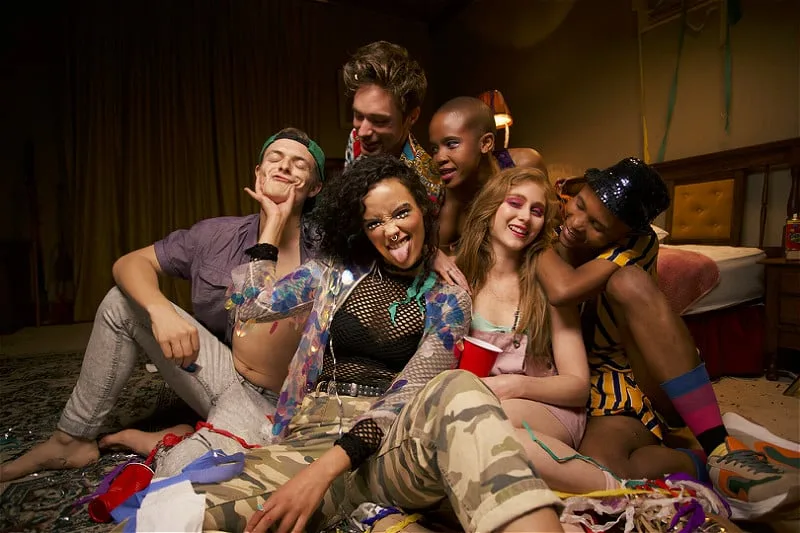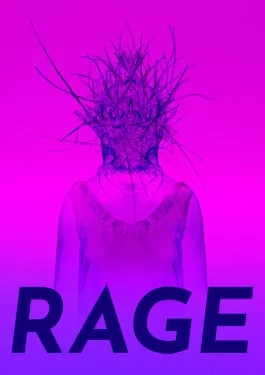
Rage (2020) contains a lot of recognisable horror elements, though it utilises some intent in how it layers these elements together. The result is a watchable, at times ambitious horror film which struggles somewhat with its later pacing, but at its best offers something visually appealing and engaging. We start with a bit of a trope: here’s a group of young South Africans, intent on partying the summer away before starting university (though that says something about how the world has changed: people now do their partying before, not during their uni courses). This block of partying is what’s known as ‘rage’, though there’s more dancing and being sick than you’d usually associate with fierce anger. Wisely introducing our key characters by name – these kinds of players can be a little samey else – we discover that the alpha of the group Kyle (Tristan De Beer) has opened up his (parents’) villa to his friends; after a few of them overdo it at the club, they head back there, and the party continues.
The next morning, in the throes of their hangovers, some of the group head out to get some supplies, enduring a Strange Cornershop Experience along the way. This rattles them a little; meeting another oddball local at the beach a little later only cements the impression that this is a strange, possibly scary neck of the woods, and that they’re vulnerable at the villa – clearly they’re from out of town, and people know they are. But what of it? Any early ideas that this is going to be a straightforward slasher, or a home invasion kind of deal are scuppered by a few visual clues: there are some unorthodox spiritual beliefs around here; small, pagan-looking offerings are seen on the beach and elsewhere. The area itself seems to be in straitened times, what with various economic issues, population shifts (significantly, there are no young people left here) and other worrying issues. So, the arrival of a bunch of usually intoxicated, naïve young people, trying to get a handle on what is unfolding around them – clearly, nothing could go wrong.
The first act of this film – let’s say the first third – is very strong. There’s a sense of awful build up as we get acquainted with our main protagonists, even if the set-up feels evocative and familiar. Actually getting a sense that these young ‘uns are flawed but essentially decent is important: nothing ever works well when we’re simply presented with fodder for the final scenes. So, it’s a little difficult to watch them missing clues, or not reacting to things which are undeniably on the periphery of their vision as they have a good time, but it’s plausible enough, and these are not unlikeable figures. The film has enough confidence to throw in a little bit of misdirection, too: that opening scream, for instance, tries to take us somewhere else.
This is also a colourful, often trippy and overblown film with lots of stylish visual appeal. It soon starts to get alarmingly reminiscent of Midsommar – sometimes looking more than simply ‘influenced by’ that film – but that is of course a modern film which set the bar for warm, summery imagery to yield something much more visceral. Speaking of similarities – though here’s another Midsommar similarity – the film’s trippy scenes also call to mind Mandy and, perhaps more so, Honeydew.
So the elements are in place: what to do with them? Some of the impetus which Rage works so hard to develop is frittered away by a drop-away in pace from the halfway point or so. Moving more into home invasion, it keeps us waiting for that but, more damagingly to the film as a whole, having set up a Midsommar-esque plot line (and no spoilers here: just look at the movie poster, as well as director Jaco Bouwer’s past projects) it struggles to answer the questions raised by all this. Ordinarily, you’d need more of a backstory for such goings-on; what is so important to the antagonists, and what do they hope to achieve exactly? Audiences will expect a main event of sorts; it’s in the eye of the beholder, but some viewers might argue that it’s not really expounded enough. It would have been so interesting to work out what was going on with the belief system here. Maybe the abandoned narrator device could have gone some way towards this?
Still, Rage knows full well not to outstay its welcome, coming in at an equally welcome, goodwill-sustaining ninety minutes (give or take). It has decent performances – if a little underwritten – it looks good, features some great, nasty scenes, and its crazy meld of genres is no bad thing. With a bit more writing and rewriting this could have been a great film but, as it stands, it’s a decent film and a perfectly enjoyable horror, which tantalises at talents yet to fully develop.
Rage is available now (on digital) from Reel 2 Reel films.
